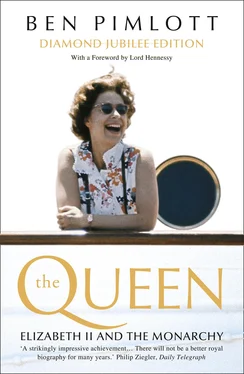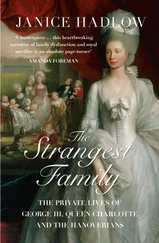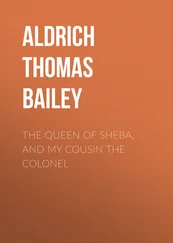As far as the King and Queen themselves were concerned, there were personal reasons for not being rushed into a precipitate match. Lady Elizabeth Bowes-Lyon had been twenty-two when she accepted the proposal of the Duke of York in 1923. Her daughter was a mere seventeen at the time of Prince Philip’s first formal request to be considered as a suitor. Queen Mary’s belief, as related to Lady Airlie, that Elizabeth’s parents simply considered her too young for marriage, may well be right. So too may Lady Airlie’s own theory that the King was miserable about the prospect of letting her go, that his elder daughter ‘was his constant companion in shooting, walking, riding – in fact in everything,’ and he dreaded losing her. 4Both views are also compatible with Wheeler-Bennett’s suggestion that the King regarded Elizabeth as not only too young but too inexperienced, and found it hard to believe that she had fallen in love with the first young man she had ever met. 5
In addition, there was the Prince himself – and here there was a contradiction that has continued to dog him all his life. Philip had a capacity to attract admiration and to cause irritation in equal measure. At the time, he was a man with enthusiastic supporters, but also with angry detractors. On the one hand, friends extolled his energy, directness, and ability to lead, attributes that brought him success at school and Dartmouth and in the Navy, and helped to win the hearts of many an English débutante and émigré countess. On the other, his forthright manner made some older people suspicious. What worked with naval ratings and princesses – abruptness, a democratic style, intolerance of humbug – grated at Court, and in the grander houses of the aristocracy. A courtier once told Harold Nicolson that both the King and the Queen ‘felt he was rough, ill-tempered, uneducated and would probably not be faithful.’ 6According to a former adviser to the King: ‘Some of the people who were guests at Balmoral thought him rather unpolished’.
There was also something else, alluded to in the last chapter: Philip’s supposed (and actual) connections with the nation which, at the time of his first overtures, Britain was engaged in fighting. For all his acquired Englishness, there was something in Philip’s character, in his tendency to put backs up, and in his mixture of rootlessness and dubious roots, that stirred in the previous generation of high aristocrats a mixture of snobbery and xenophobia. ‘The kind of people who didn’t like Prince Philip were the kind who didn’t like Mountbatten,’ suggests an ex-courtier. ‘It was all bound up in the single word: “German”.’ 7
In view of the Germanic links of the British Royal Family over the preceding two centuries, this was scarcely a rational prejudice, but it was undoubtedly there. The strongest evidence of its existence is provided by unpublished sections of the diary of Jock (later Sir John) Colville, who had been a private secretary to Neville Chamberlain and then to Winston Churchill, and became Princess Elizabeth’s private secretary in the summer of 1947. During his first stay at Balmoral in the same year, Colville noted with fascination the prevailing atmosphere of bitterness towards the ex-Greek prince. ‘Lords Salisbury, Eldon and Stanley think him no gentleman,’ he recorded; ‘and in a sense they are right. They also profess to see in him a Teutonic strain.’ 8‘People in the generation which had fought in the First World War were not very much in favour of what they called “the Hun”,’ says a former adviser to George VI. 9An aristocrat linked to the Conservative Party used privately to refer to Philip as ‘Charlie Kraut’. 10One of the fiercest of Philip’s opponents was the Queen’s brother, David Bowes-Lyon, who did his best to influence his sister against the match. 11
What exactly did being ‘no gentleman’ mean? There were several, generally unspoken elements. ‘He wasn’t part of the aristocracy’, suggests a former courtier meaning that he did not share British aristocratic assumptions. 12This point was linked to the unfortunate matter of his schooling. The problem was not its extent – if high scholastic attainment had been a requirement for joining the Windsor family, few twentiethcentury consorts (let alone the royals they married) would have passed muster – but its location. It was a significant disadvantage that he was not a member of the freemasonry of old Etonians to which virtually everybody in the inner circle who was not actually a Royal Highness, almost by definition, belonged. 13
Philip’s unusual academy, regarded by the world at large as an interesting variation, contributed to the sense of him as an outsider – even possibly, like his uncle, as a kind of socialist. ‘He had been at Gordonstoun,’ points out a former royal aide. ‘So he had very few friends. Eton engenders friendships. The more severe ethos at Gordonstoun leaves you without friends.’ (Being ‘without friends’ should not, of course, be taken literally: what it meant was friends of an appropriate type. The same source acknowledges that, though Philip did have friends, they tended to be ‘Falstaffian’ ones. 14) In addition, Gordonstoun’s ‘progressive’ ethos could give rise to disturbing ideas. Thus, one member of the Royal Family apparently complained that the would-be consort ‘had been to a crank school with theories of complete social equality where the boys were taught to mix with all and sundry.’ 15
There was no single, or over-riding, objection: just the raised eyebrow, the closing of ranks at which royalty and the landed classes were peculiarly adept. If there was a unifying theme, it was a kind of jealous, chauvinistic protectiveness – based on a belief that so precious an asset should not be lightly handed over, least of all to the penniless scion of a disreputable house who, in the nostrils of his critics, had about him the whiff of a fortune-hunter. Contemplating the presence of ‘Philip of Greece’ and his cousin the Marquess of Milford Haven at the Boxing Day party at Windsor Castle in 1943, Sir Alan Lascelles laconically observed: ‘I prefer the latter’. 16Whatever the full reason, a courtly and aristocratic distaste for the young suitor, and suspicion about his motives, hindered his full acceptance into courtly and aristocratic circles for years to come.
ONE PERSON had no doubts: Princess Elizabeth herself. ‘She was a stunning girl’, a close friend fondly remembers, ‘longing to be a young wife without too many problems.’ 17In this ambition she was supported by most public opinion, apart from a sliver of the Labour Party on the pro-Communist left, which continued to associate Philip not with the Hun, but with the Greek right. In general, however, press and public took what they saw: a handsome, eligible naval officer, who happened to be a prince. So far from objecting, most early commentators found his combination of royal status, a British naval commission, and lack of celebrity, entirely appropriate for the back-seat but decorative role that would be required. Yet for the time being, Philip remained a shadowy figure.
Elizabeth, by contrast, was ever more visible in the popular magazines – with interest enhanced by speculation about the developing but unannounced romance. The American press, always ahead of the British, anticipated an engagement early in 1947 by turning her into a cover girl, a newsreel star, and – highest compliment – the ultimately desirable girl-next-door. In January 1947, the International Artists’ Committee in New York voted her one of the most glamorous women in the world. In March, Time declared her ‘the Woman of the Week’, and praised her for her ‘Pin-Up Charm’. Devoting four pages to her life story, it revealed her as a princess the magazine’s readers could take to their hearts. She was practical, down-to-earth, human – the essence of suburban middle America. As well as being an excellent horsewoman she was, the article declared, a tireless dancer and an enthusiastic lover of swing music, night clubs, and ‘having her own way’. She enjoyed reading best-sellers, knitting and gossipy teas with her sister and a few girlfriends in front of the fire at Buckingham Palace. 17
Читать дальше












